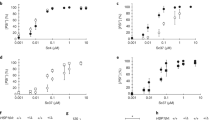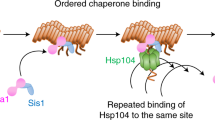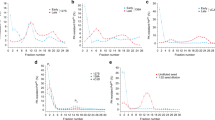Abstract
Aggregation-prone proteins often misfold into multiple distinct amyloid conformations that dictate different physiological impacts. Although amyloid formation is triggered by a transient nucleus, the mechanism by which an initial nucleus is formed and allows the protein to form a specific amyloid conformation has been unclear. Here we show that, before fiber formation, the prion domain (Sup35NM, consisting of residues 1–254) of yeast prion Sup35, the [PSI+] protein determinant, forms oligomers in a temperature-dependent, reversible manner. Mutational and biophysical analyses revealed that 'non-native' aromatic interactions outside the amyloid core drive oligomer formation by bringing together different Sup35NM monomers, which specifically leads to the formation of highly infectious strain conformations with more limited amyloid cores. Thus, transient non-native interactions in the initial nucleus are pivotal in determining the diversity of amyloid conformations and resulting prion strain phenotypes.
This is a preview of subscription content, access via your institution
Access options
Subscribe to this journal
Receive 12 print issues and online access
$259.00 per year
only $21.58 per issue
Buy this article
- Purchase on Springer Link
- Instant access to full article PDF
Prices may be subject to local taxes which are calculated during checkout





Similar content being viewed by others
References
Chien, P., Weissman, J.S. & DePace, A.H. Emerging principles of conformation-based prion inheritance. Annu. Rev. Biochem. 73, 617–656 (2004).
Chiti, F. & Dobson, C.M. Protein misfolding, functional amyloid, and human disease. Annu. Rev. Biochem. 75, 333–366 (2006).
Kodali, R. & Wetzel, R. Polymorphism in the intermediates and products of amyloid assembly. Curr. Opin. Struct. Biol. 17, 48–57 (2007).
Collinge, J. Prion diseases of humans and animals: their causes and molecular basis. Annu. Rev. Neurosci. 24, 519–550 (2001).
Wickner, R.B. [URE3] as an altered URE2 protein: evidence for a prion analog in Saccharomyces cerevisiae. Science 264, 566–569 (1994).
Tuite, M.F. & Koloteva-Levin, N. Propagating prions in fungi and mammals. Mol. Cell 14, 541–552 (2004).
Tessier, P.M. & Lindquist, S. Unraveling infectious structures, strain variants and species barriers for the yeast prion [PSI+]. Nat. Struct. Mol. Biol. 16, 598–605 (2009).
Derkatch, I.L., Chernoff, Y.O., Kushnirov, V.V., Inge-Vechtomov, S.G. & Liebman, S.W. Genesis and variability of [PSI] prion factors in Saccharomyces cerevisiae. Genetics 144, 1375–1386 (1996).
Kochneva-Pervukhova, N.V. et al. [PSI+] prion generation in yeast: characterization of the 'strain' difference. Yeast 18, 489–497 (2001).
Tanaka, M., Chien, P., Naber, N., Cooke, R. & Weissman, J.S. Conformational variations in an infectious protein determine prion strain differences. Nature 428, 323–328 (2004).
Caughey, B. & Lansbury, P.T. Protofibrils, pores, fibrils, and neurodegeneration: separating the responsible protein aggregates from the innocent bystanders. Annu. Rev. Neurosci. 26, 267–298 (2003).
Johnson, S.M. et al. Native state kinetic stabilization as a strategy to ameliorate protein misfolding diseases: a focus on the transthyretin amyloidoses. Acc. Chem. Res. 38, 911–921 (2005).
Haass, C. & Selkoe, D.J. Soluble protein oligomers in neurodegeneration: lessons from the Alzheimer's amyloid beta-peptide. Nat. Rev. Mol. Cell Biol. 8, 101–112 (2007).
Balch, W.E., Morimoto, R.I., Dillin, A. & Kelly, J.W. Adapting proteostasis for disease intervention. Science 319, 916–919 (2009).
Serio, T.R. et al. Nucleated conformational conversion and the replication of conformational information by a prion determinant. Science 289, 1317–1321 (2000).
King, C.Y. & Diaz-Avalos, R. Protein-only transmission of three yeast prion strains. Nature 428, 319–323 (2004).
Scheibel, T. & Lindquist, S.L. The role of conformational flexibility in prion propagation and maintenance for Sup35p. Nat. Struct. Biol. 11, 958–962 (2001).
Collins, S.R., Douglass, A., Vale, R.D. & Weissman, J.S. Mechanism of prion propagation: amyloid growth occurs by monomer addition. PLoS Biol. 2, e321 (2004).
Tanaka, M. et al. Expansion of polyglutamine induces the formation of quasi-aggregate in the early stage of protein fibrillization. J. Biol. Chem. 278, 34717–34724 (2003).
Glatter, O. & Kratky, O. Small Angle X-ray Scattering (Academic Press, New York, 1982).
Walsh, D.M. et al. Naturally secreted oligomers of amyloid beta protein potently inhibit hippocampal long-term potentiation in vivo. Nature 416, 535–539 (2002).
Kayed, R. et al. Common structure of soluble amyloid oligomers implies common mechanism of pathogenesis. Science 300, 486–489 (2003).
Lee, S. & Eisenberg, D. Seeded conversion of recombinant prion protein to a disulfide-bonded oligomer by a reduction-oxidation process. Nat. Struct. Biol. 10, 725–730 (2003).
Plakoutsi, G. et al. Evidence for a mechanism of amyloid formation involving molecular reorganisation within native-like precursor aggregates. J. Mol. Biol. 351, 910–922 (2005).
Eakin, C.M., Berman, A.J. & Miranker, A.D. A native to amyloidogenic transition regulated by a backbone trigger. Nat. Struct. Mol. Biol. 13, 202–208 (2006).
Jahn, T.R., Parker, M.J., Homans, S.W. & Radford, S.E. Amyloid formation under physiological conditions proceeds via a native-like folding intermediate. Nat. Struct. Mol. Biol. 13, 195–201 (2006).
Toyama, B.H., Kelly, M.J., Gross, J.D. & Weissman, J.S. The structural basis of yeast prion strain variants. Nature 449, 233–237 (2007).
Liu, J.J. & Lindquist, S. Oligopeptide-repeat expansions modulate 'protein-only' inheritance in yeast. Nature 400, 573–576 (1999).
Krishnan, R. & Lindquist, S.L. Structural insights into a yeast prion illuminate nucleation and strain diversity. Nature 435, 765–772 (2005).
Tessier, P.M. & Lindquist, S. Prion recognition elements govern nucleation, strain specificity and species barriers. Nature 447, 556–561 (2007).
Glover, J.R. et al. Self-seeded fibers formed by Sup35, the protein determinant of [PSI+], a heritable prion-like factor of S. cerevisiae. Cell 89, 811–819 (1997).
Tanaka, M., Chien, P., Yonekura, K. & Weissman, J.S. Mechanism of cross-species prion transmission: an infectious conformation compatible with two highly divergent yeast prion proteins. Cell 121, 49–62 (2005).
Nelson, R. et al. Structure of the cross-β spine of amyloid-like fibrils. Nature 435, 773–778 (2005).
Shewmaker, F., Wickner, R.B. & Tycko, R. Amyloid of the prion domain of Sup35p has an in-register parallel beta-sheet structure. Proc. Natl. Acad. Sci. USA 103, 19754–19759 (2006).
Chen, S., Ferrone, F.A. & Wetzel, R. Huntington's disease age-of-onset linked to polyglutamine aggregation nucleation. Proc. Natl. Acad. Sci. USA 99, 11884–11889 (2002).
Xue, W.F., Homans, S.W. & Radford, S.E. Systematic analysis of nucleation-dependent polymerization reveals new insights into the mechanism of amyloid self-assembly. Proc. Natl. Acad. Sci. USA 105, 8926–8931 (2008).
Shorter, J. & Lindquist, S. Hsp104 catalyzes formation and elimination of self-replicating Sup35 prion conformers. Science 304, 1793–1797 (2004).
Inoue, Y., Taguchi, H., Kishimoto, A. & Yoshida, M. Hsp104 binds to yeast Sup35 prion fiber but needs other factor(s) to sever it. J. Biol. Chem. 279, 52319–52323 (2004).
Tipton, K.A., Verges, K.J. & Weissman, J.S. In vivo monitoring of the prion replication cycle reveals a critical role for Sis1 in delivering substrates to Hsp104. Mol. Cell 32, 584–591 (2008).
Tanaka, M., Collins, S.R., Toyama, B.H. & Weissman, J.S. The physical basis of how prion conformations determine strain phenotypes. Nature 442, 585–589 (2006).
Duennwald, M.L., Jagadish, S., Muchowski, P.J. & Lindquist, S. Flanking sequences profoundly alter polyglutamine toxicity in yeast. Proc. Natl. Acad. Sci. USA 103, 11045–11050 (2006).
Thakur, A.K. et al. Polyglutamine disruption of the huntingtin exon 1 N terminus triggers a complex aggregation mechanism. Nat. Struct. Mol. Biol. 16, 380–389 (2009).
Fujisawa, T. et al. Small-angle X-ray scattering station at the SPring-8 RIKEN beamline. J. Appl. Cryst. 33, 797–800 (2000).
Ameyama, Y. et al. Large-aperture TV detector with a beryllium-windowed image intensifier for x-ray diffraction. Rev. Sci. Instrum. 66, 2290–2294 (1995).
Guinier, A. & Fournet, G. Small-Angle Scattering of X-rays (John Wiley & Sons, New York, 1955).
Svergun, D.I., Semenyuk, A.V. & Feigin, L.A. Small-angle-scattering-data treatment by the regularization method. Acta Crystallogr. 44, 244–250 (1988).
Lehrer, S.S. Intramolecular pyrene excimer fluorescence: a probe of proximity and protein conformational change. Methods Enzymol. 278, 286–295 (1997).
Acknowledgements
We thank Y. Sakamaki and T. Akagi for help with the EM experiments and S. Akiyama for discussion of the SAXS measurements. Y.O. is supported by a Japan Society for the Promotion of Science (JSPS) postdoctoral fellowship. Funding was provided by the JST-PRESTO, the Ministry of Education, Culture, Sports, Science and Technology (MEXT), the Ministry of Health, Labour and Welfare (MHLW) and The Uehara Memorial Foundation (M.T.) and by the Howard Hughes Medical Institute and the US National Institutes of Health (J.S.W.).
Author information
Authors and Affiliations
Contributions
M.T. and Y.O. designed the experiments. Y.O. performed most experiments, K.I. contributed to setup of the SAXS experiments and B.H.T. helped the NMR experiments. B.H.T. and J.S.W. provided new reagents. Y.O., J.S.W. and M.T. analyzed and discussed the data and wrote the paper.
Corresponding author
Ethics declarations
Competing interests
The authors declare no competing financial interests.
Supplementary information
Supplementary Text and Figures
Supplementary Methods and Supplementary Figures 1–9 (PDF 1807 kb)
Rights and permissions
About this article
Cite this article
Ohhashi, Y., Ito, K., Toyama, B. et al. Differences in prion strain conformations result from non-native interactions in a nucleus. Nat Chem Biol 6, 225–230 (2010). https://doi.org/10.1038/nchembio.306
Received:
Accepted:
Published:
Issue Date:
DOI: https://doi.org/10.1038/nchembio.306
This article is cited by
-
Amyloid conformation-dependent disaggregation in a reconstituted yeast prion system
Nature Chemical Biology (2022)
-
Short disordered protein segment regulates cross-species transmission of a yeast prion
Nature Chemical Biology (2020)
-
A complete catalog of wild-type Sup35 prion variants and their protein-only propagation
Current Genetics (2020)
-
A Decentralized Approach to the Formulation of Hypotheses: A Hierarchical Structural Model for a Prion Self-Assembled System
Scientific Reports (2016)
-
Layers of structure and function in protein aggregation
Nature Chemical Biology (2015)



